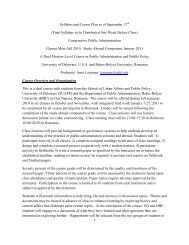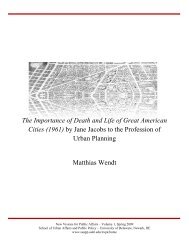New Visions for Public Affairs Volume 1 - School of Public Policy ...
New Visions for Public Affairs Volume 1 - School of Public Policy ...
New Visions for Public Affairs Volume 1 - School of Public Policy ...
Create successful ePaper yourself
Turn your PDF publications into a flip-book with our unique Google optimized e-Paper software.
Wendt, Matthias Death and Life by Jane Jacobs 6<br />
rearranging each <strong>of</strong> them in relative self-containment.<br />
Jacobs also criticized Howard’s disinterest in the multifaceted<br />
metropolitan cultural life, and his lack <strong>of</strong> insight<br />
in how great cities police themselves and how they<br />
serve as places <strong>of</strong> innovation and creative hubs <strong>of</strong> the<br />
economy (Jacobs, 1961).<br />
Howard’s ideas were enthusiastically adopted in<br />
America during the 1920s and refined by members <strong>of</strong><br />
the Regional Planning Association <strong>of</strong> America,<br />
including Lewis Mum<strong>for</strong>d, Clarence Stein, and Henry<br />
Wright. Their main goal was to decentralize the big<br />
cities, thin them out and disperse their businesses and<br />
residents into smaller, self-contained cities and rural<br />
towns. The “Decentrists” popularized anti-urban ideas<br />
such as turning houses away from the street and toward<br />
sheltered greens, since the street would be a bad<br />
environment <strong>for</strong> humans. They further propagated the<br />
super block instead <strong>of</strong> the street as the basic unit <strong>of</strong> city<br />
design as well as the segregation <strong>of</strong> residences,<br />
commerce and green spaces. The Decentrists’ notion<br />
that the presence <strong>of</strong> many people in a neighborhood is<br />
evil and that good city planning must aim <strong>for</strong> the<br />
illusion <strong>of</strong> suburban privacy collided with Jacobs’ idea<br />
<strong>of</strong> variously used streets and densely populated<br />
neighborhoods. Jacobs particularly spoke against the<br />
omniscient role <strong>of</strong> the planner controlling every<br />
significant detail in the planning process (Jacobs,<br />
1961).<br />
Jacobs judges Le Corbusier’s Radiant City as the most<br />
dramatic idea to apply anti-city planning to existing<br />
cities, not only planning a completely new physical<br />
environment but also a social utopia. Le Corbusier’s<br />
Radiant City was composed <strong>of</strong> huge skyscrapers in a<br />
park-like setting. Jacobs detects great similarities<br />
between Howard and Le Corbusier. By adapting<br />
Howard’s ideas <strong>of</strong> the Garden City to a modernist<br />
metropolis <strong>of</strong> highrises, Le Corbusier was able to<br />
accommodate much higher densities <strong>of</strong> people. His<br />
vertical Garden City was planned to house 1,200<br />
inhabitants per acre. The skyscrapers <strong>of</strong> the core area<br />
would cover only 5 percent <strong>of</strong> the ground, leaving 95<br />
percent <strong>for</strong> open space and parks. Jacobs conceives<br />
orthodox planning as a combination <strong>of</strong> the Garden City<br />
and the Radiant City, since highway planners,<br />
legislators, land use planners and parks and playground<br />
planners constantly use these two powerful visions as<br />
fixed points <strong>of</strong> reference (Jacobs, 1961).<br />
Another ancestor to orthodox planning, according to<br />
Jacobs, is the City Beautiful movement. Originating<br />
from the great Columbian Exposition in Chicago in<br />
1893, the movement was dominated by Daniel<br />
Burnham, who became the leading City Beautiful<br />
planner. It drew up large schemes <strong>of</strong> boulevards and<br />
civic or cultural centers in a retrogressive imitation <strong>of</strong><br />
Renaissance style. All these monumental centers sorted<br />
out certain cultural and public functions and separated<br />
them from the rest <strong>of</strong> the city. Jacobs observes that the<br />
surrounding areas deteriorated and attracted<br />
questionable uses and decay.<br />
Jacobs (1961) argues that these modernist conceptions<br />
have harmoniously merged “into a sort <strong>of</strong> Radiant<br />
Garden City Beautiful” as the foundation <strong>of</strong> orthodox<br />
<strong>New</strong> <strong>Visions</strong> <strong>for</strong> <strong>Public</strong> <strong>Affairs</strong> – <strong>Volume</strong> 1, Spring 2009<br />
<strong>School</strong> <strong>of</strong> Urban <strong>Affairs</strong> and <strong>Public</strong> <strong>Policy</strong> – University <strong>of</strong> Delaware, <strong>New</strong>ark, DE<br />
www.suapp.udel.edu/nvpa/home







